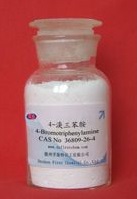Background and overview[1]
4-Bromotriphenylamine is an organic synthesis intermediate that can be used in organic synthesis and laboratory research and development processes.
Preparation[1]
Preparation of 4-bromotriphenylamine: first cover the single-necked flask of the reaction vessel with a layer of tinfoil and perform light-shielding treatment, then place 0.0025mol triphenylamine C1 into the light-shielding single-necked flask, and add 40mL of chloroform. Dissolve the reactants, turn on the stirrer, and maintain the cold bath state at 0°C; after 15 minutes, add N-bromosuccinimide in small amounts and multiple times within 20 minutes (generally, NBS can be 0.00258 ~ 0.00275 mol , 0.0026 mol in Example 1), after the addition, continue to stir and cool in a cold bath for 8 hours, use a rotary evaporator to remove the chloroform in the crude product, and use a solution with a volume ratio of n-hexane to dichloromethane of 6:1 as The eluent was separated and purified through a silica gel chromatography column, the product was collected, and the eluent was removed using a rotary evaporator to obtain 0.6742g of product C2. The name of C2 is 4-bromotriphenylamine, the molecular formula is C18H14BrN, and the yield is 84.66%.

Apply[2]
Preparation of a triphenylamine-fluorinated aryl benzyl ether dendritic ligand-substituted silicon phthalocyanine from 4-bromotriphenylamine. First, 4-bromotriphenylamine and phenylboronic acid synthesize 4′-(diphenylamino)-[1,1′-biphenyl]-4-carboxylic acid; then, 4′-(diphenylamino)-[1 , 1′-biphenyl]-4-carboxylic acid is condensed with hexafluorobisphenol A or bisphenol A to prepare 4-(diphenyl amino)-1-biphenyl acid-1-phenyl ester-1,1, 1,3,3,3-hexafluoropropylphenol and 4-(diphenylamino)-1-biphenyl-1-phenylpropylphenol. Finally, 4-(diphenylamino)-1-biphenyl-1-phenylester-1,1,1,3,3,3-hexafluoropropylphenol and 4-(diphenylamino) -1-phenylacetopropylphenol reacts with dichlorosilyl phthalocyanine to synthesize di-(4-(diphenylamino)-1-phenylacetopropyl-4-(biphenylate)) 1,1,1,3,3,3-hexafluoropropyl-4phenoxy) axially substituted silicon phthalocyanine and bis-(4-(diphenylamino)-1-biphenyl acid-1- Phenylpropylphenoxy) axially substituted silicon phthalocyanine can be used as a fluorescent imaging agent and a photosensitizer for photodynamic therapy.
Main reference materials
[1] CN201811482699.4 4-(2-thienyl)triphenylamine and its derivatives, preparation methods and applications
[2] CN201811015652.7 triphenylamine fluorinated aryl benzyl ether dendritic ligand substituted silicon phthalocyanine and its preparation method and application

 微信扫一扫打赏
微信扫一扫打赏

